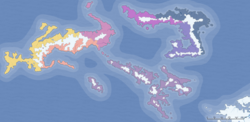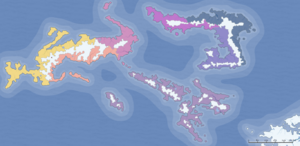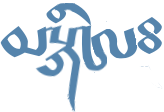Meskangela: Difference between revisions
m (→Writing system) |
|||
| Line 91: | Line 91: | ||
| font-size:24px;"| ཕ || [pʰ] || ''ph'' || font-size:24px;"| པ || [p] || ''p'' || font-size:24px;"| ཧ || [h~ɦ], *[f] || ''h'' || font-size:24px;"| བ || [w] || ''w'' || font-size:24px;"| མ || [m] || ''m'' || [l] || [a], *[aʱ] | | font-size:24px;"| ཕ || [pʰ] || ''ph'' || font-size:24px;"| པ || [p] || ''p'' || font-size:24px;"| ཧ || [h~ɦ], *[f] || ''h'' || font-size:24px;"| བ || [w] || ''w'' || font-size:24px;"| མ || [m] || ''m'' || [l] || [a], *[aʱ] | ||
|- align=center | |- align=center | ||
! [[w: | ! [[w:Trill consonant|Trill]] | ||
| font-size:24px;"| རྷ || [r̥] || ''rh'' || font-size:24px;"| ར || [r] || ''r'' || font-size:24px;"| རྲ || [d͡z] || ''ʒ'' ||colspan=6 | — || ''l'' || ''a'' | | font-size:24px;"| རྷ || [r̥] || ''rh'' || font-size:24px;"| ར || [r] || ''r'' || font-size:24px;"| རྲ || [d͡z] || ''ʒ'' ||colspan=6 | — || ''l'' || ''a'' | ||
|- align=center | |- align=center | ||
Revision as of 16:28, 16 July 2022
| Meskangela language | |
|---|---|
| མསྐཾངེལཿ Mëskaŋelā | |
 | |
| Created by | Raistas |
| Setting | planet Earth (Europe) |
Sino-Tibetan
| |
Early form | *Proto-Himalayan
|
Meskangela (Classical Meskangela: མསྐཾངེལཿ mëskaŋelā; Western མསྐཾངེལཿ mëskaŋela; Eastern མསྐཾངེལཿ mëskåŋeła; Southern མཁཾངྃག măkhoŋäg) is a Himalayan language of an unknown origin. The most common hypothesis suggests its origin in the West Himalayan region and migrated westward over the period of three thousand years. For a millennium, Old Meskangela served as a language of public life and administration as well as a language of divine worship. The Classical Meskangela (also known as “Meskangela Proper” མསྐཾངེལཿ རནཏཾཀེ Meskangela Rántake) was a standardised dialect that emerged from Old Meskangela in approximately 300 BNE and remained spoken until the New Era, after which it remained only a written standard, as local dialects gained more recognition and prominence. Seven dialects are still spoken, but only the Southern variety diverges from the classical spelling and uses its own modified version of the Meskangēl script.
New Meskangela dialects are written in the Meskangēl script, a descendant of the Ancient Himalayan script, and the classical variety remains most prominent. The earliest inscriptions date from 13th century BNE, although such inscriptions remained scarce until approximately 500 BNE, when first religious texts were written. However, the linguistic history of Meskangela prior to the appearance of such textual sources remains unknown.
Name and history
The name of the language was coined during the classical period from the word སྐཾང་ skaŋ “mountain” and means “pertaining to the mountains”, since the land where it was traditionally spoken is mountainous. Other groups used different terms to refer to themselves and their languages: མྸཾཨྃལཿ mágailā “Southern”, སྱ྅རེལཿ syörilā “Western”, ཀལོནེལཿ këlónelā “Plain dialect”, ཁམེལཿ khëmelā “Coastal dialect”.
Historically Meskangela had always been the language of the mountainous islands. Its origin, however, is obscure, as all documentations of the previous eras were lost, and local folklore only briefly mentions an ancient journey to the west, called ཨཱགརྭཾཏུ Āgërwatu. Little is known about the language of that period itself, its phonology is the only part that is well understood, which allows to reconstruct many Proto-Meskangela words. By around 1300 BNE, the Meskanel people had a many chiefdoms in all of the three main islands. During that period the written language rose to prominence and was standardised for the first time (300 BNE). Later, Meskangela Proper became a prestige language after being adopted as a lingua franca between its various dialects. The dialects themselves had already developed their distinctive features by the classical period, and Meskangela Proper was not a common ancestor of those dialects, instead it was a standardised variety of the Central Syörilā, which comprises Western and Eastern Tūŋëdēla (“Innersea”) group. During the New Era Meskangela is still often referred as a single language, even though by the end of the classical period it had already been a group of closely related languages. The most accurate term to describe Meskangela as a whole is a dialect continuum.
Geographic distribution
The Meskangela language is spoken on three main landmasses, which are used to group its dialects: འས྅རིཀཿ Hasörikā “Westland”, སྱཾརལིངཿ Syarëliŋā “Eastland” and མྸཾགཾརིཀཿ Mágårikā “Southland”, as well as on many islands surrounding the landmasses. There are also some small communities in the southern continent Lyökimëranā, but most of those settlements are recent, and for the most part originate from the Southland.
Dialects
Linguistically speaking, Meskangela is not a single language, but a group of closely related languages, divided into three subgroups: Western, Eastern and Southern, based on their relative location. Some dialects within one subgroup may differ more from each other than other dialects belonging to different subgroups, which mostly depends on their geographic isolation and influence of the standard language. Some dialects are mutually intelligible, whereas others are not, not unlike the situation of a typical dialect continuum. Several varieties still use different names for themselves: a relatively divergent far Eastern variety is called Khīmła [ˈkʰiː.wɑ], Southeastern dialects – Majäg [ˈma.jɛɣ], Southwestern – Gakhō Łatem [ɣa.ˈkʰy. ʟa.ˈteʊ]. Most dialects can be described as either "Western", "Eastern" or "Southern", which corresponds to three main islands. It is also important to draw a distinction between later dialects of the New Era (often called "New Meskangela"), the classical variety used as a written, but not a spoken language, and those that are extinct. Thus, it is convenient to classify these dialects as "Modern", "Middle" or "Classical", and "Old", alongside the classification, based on geograhic areas.
Writing system
The Meskangela script was based on the Ancient Himalayan script. With time, it developed its distinctive style and characters, specifically vowel markers, which were seldom used in writing Old Meskangela. The later varieties adopted this script with minor modifications. The other main writing system used for Meskangela, mostly after the classical period, was a cursive script.
| Consonants | ||||||||||||||||||
|---|---|---|---|---|---|---|---|---|---|---|---|---|---|---|---|---|---|---|
| Aspirated | Unaspirated | Fricative | Voiced | Nasal | Lateral approximant |
Glottal | ||||||||||||
| letter | sound | rom. | letter | sound | rom. | letter | sound | rom. | letter | sound | rom. | letter | sound | rom. | ལྷ | — | ||
| Velar | ཁ | [kʰ] | kh | ཀ | [k] | k | ཨ | [ɣ~∅], *[x] | g | ག | [ɣ] | g | ང | [ŋ] | ŋ | [ɬ] | ||
| Palatal | ཆ | [t͡ɕʰ] | ch | ཅ | [t͡ɕ] | c | ས | [s] | s | ཡ | [j] | j | — | lh | ||||
| Dental | ཁ | [tʰ] | th | ཀ | [t] | t | ཞ | [θ] | z | ཨ | [ð̞~ɹ] | d | ན | [n] | n | ལ | འ | |
| Labial | ཕ | [pʰ] | ph | པ | [p] | p | ཧ | [h~ɦ], *[f] | h | བ | [w] | w | མ | [m] | m | [l] | [a], *[aʱ] | |
| Trill | རྷ | [r̥] | rh | ར | [r] | r | རྲ | [d͡z] | ʒ | — | l | a | ||||||
| Vowels and semivowels | ||||||||||||||||||
| vowel | sound | rom. | vowel | sound | rom. | vowel | sound | rom. | vowel | sound | rom. | vowel | sound | rom. | vowel | sound | rom. | |
| Short vowels | ◌ི | [i] | i | ◌ུ | [u] | u | ◌ེ | [e] | e | ◌ོ | [o] | o | ◌ཾ | [a] | a | ◌ | [ə] | ë |
| Long vowels | ◌ཱི | [iː] | ī | ◌ཱུ | [uː] | ū | ◌ཻ | [eː] | ē | ◌ཽ | [oː] | ō | ◌ཱ | [aː] | ā | ◌྅ | [øː] | ö |
| Diphthongs | ◌ྃ | [aɪ] | ai | ◌ྂ | [aʊ] | au | ◌ཿ | *[aʱ] | ā | ◌ྸ | [˥] | ◌́ | ◌ྱ | [ʲ] | y | ◌ྭ | [ʷ] | w |
The table above demonstrates all characters of the Meskangēl script and their classical pronunciation. Individual dialects may vary greatly over the way certain characters are pronounced, and some dialects do not use certain letters, while others still retain the Classical Meskangela spelling, even though the pronunciation is different. For example, the Eastern variety does not use "◌ྂ" (au), replacing it with "◌ཱུ" (ū) everywhere, and uses "ཨ" to represent [l], while the Southern variety does not use letters "ཨ" and "ཞ", the tone symbol "◌ྸ" and the "◌ཿ " ending and ignore those characters while reading.

